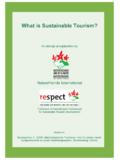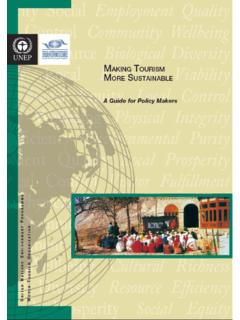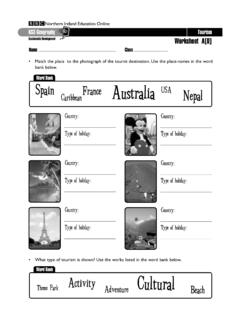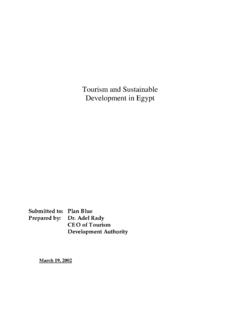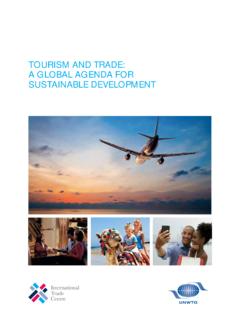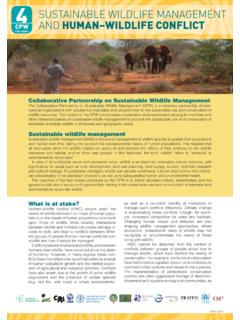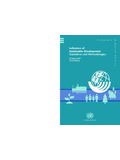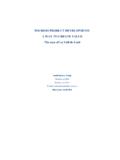Transcription of TOURISM AND THE ENVIRONMENT - Notice …
1 TOURISM AND THE ENVIRONMENTF ilte Ireland s Environmental Action Plan2007-20091 F ILTE IRELAND S ENVIRONMENTAL ACTION PLAN 2007-2009 Introduction 02 The importance of the ENVIRONMENT for TOURISM 04 Environmental challenges facing the TOURISM industry 08 Sustainable TOURISM 12 Environmental Action Plan 2007-2009: Five key objectives 161. Place environmental issues at the core of sustainable TOURISM policy at national, regional and local levels 182. Advocate for the protection of key environmental and TOURISM assets 193.
2 Undertake research leading to a clearer understanding of the relationship between TOURISM and the ENVIRONMENT 204. Promote good environmental practice within the TOURISM sector and advise on the development of ecotourism 225. Work with strategic partners to implement this Action Plan 24 Table of contentspageIntroduction2 The future of Irish TOURISM is inextricably linked to the quality ofthe ENVIRONMENT . Our scenic landscapes, coastline, rivers and lakes,and cultural heritage are the bedrock upon which Irish TOURISM hasbeen built.
3 The economic viability and competitiveness of the Irishtourism industry can only be sustained if the quality of these resources is maintained. Now, more than ever, Ireland s TOURISM industry relies on strong and appropriate environmental a common property resource, the ENVIRONMENT is vulnerable to damage because people can benefit from exploiting it without having to pay any owners . Overuse and conflicts between users result, which have to be resolved by a variety of policy interventions, including laws, agreements, charges, rights allocation, and other such measures.
4 These are the main options for policy. ENVIRONMENTAL COMMITMENTIn 2005, F ilte Ireland set up an ENVIRONMENT Unit which is now part of the Policy and Planning Unit. The purpose of the Unit is to advocate a high quality physical ENVIRONMENT for TOURISM and to promote good environmental practice throughout the TOURISM sector. As part of its role as a prescribed body in the planning process, F ilte Ireland also aims to strengthen its partnerships with Local carrying out its functions, F ilte Ireland will also work with other public bodies such as the Environmental Protection Agency, the Heritage Council, Sustainable Energy Ireland and the Department of the ENVIRONMENT , Heritage and Local Government.
5 In advocating a sound TOURISM basis for effective environmental ACTION PLAN 2007-2009F ilte Ireland s three-year Environmental Action Plan discusses the environmental challenges facing the Irish TOURISM industry and sets out what F ilte Ireland will do to address these challenges in order to ensure the sustainable growth of the sector. It also sets out a range of partnerships that are necessary between F ilte Ireland and other agencies and bodies in order to achieve its Action Plan also takes account of national policy on sustainable development, Sustainable Development: A Strategy for Ireland, which was published by the Government in 1997.
6 This document was updated in the document Making Ireland s Development Sustainable: Review, Assessment and Future Action in 2002. The Environmental Action Plan 2007-2009 also takes account of the EPA s state of the ENVIRONMENT report, Ireland s ENVIRONMENT (2004), its ENVIRONMENT in Focus report (2006); and the report of the TOURISM Policy Review Group, New Horizons for Irish TOURISM : An Agenda for Action (2003).3 The importance of the environmentfor tourism4In 2006, overseas tourist visits to Ireland increased to an estimated million; TOURISM total foreign exchange earnings were billion; and the TOURISM and hospitality sector supported 12% of jobs in visitor surveys repeatedly confirm that Ireland is prized by overseas visitors for its clean, green image1.
7 In 2006: 80% of visitors rated Ireland s scenery as an important reason for visiting Ireland; 74% said they were attracted by the natural unspoilt ENVIRONMENT ; and 58% mentioned Ireland s attractive cities and addition, in 2006, 75% of overseas visitors agreed with the statement that Ireland is a clean and environmentally green destination . The TOURISM industry has successfully traded on Ireland s positive environmental image for decades, but unprecedented economic growth in recent years has put the quality of this core TOURISM product under increasing TOURISM assets, which are important for the sustainable growth of TOURISM in Ireland, should be safeguarded from encroachment and damage by inappropriate development.
8 These assets include special landscapes, important views, good water quality, the setting of historic buildings and monuments, biodiversity and access points to the coast and open that impacts on the ENVIRONMENT , in which TOURISM is a stakeholder, is F ilte Ireland s concern. The industry is dependent upon the country s natural ENVIRONMENT and cultural heritage to sustain the distinctive Irish TOURISM product and to develop environmentally-based ecotourism products. F ilte Ireland must ensure that the beneficial uses to TOURISM of a range of environmental resources - particularly water - are made clear to those with a responsibility for protecting them.
9 The importance of high quality water for angling, cruising, water sports and bathing cannot be overemphasised. There has been sizable expenditure on infrastructure to clean up Ireland s waters in recent years. However Lawlor et , 2007, show that spending has not always been well targeted at the objective of improving water quality, and that the results of investment were not properly tracked subsequently, in order to learn from experience. Similarly, according to F ilte Ireland s annual Visitor Attitudes Survey, the attitudes of overseas visitors to litter have changed very little since 1999 despite various central and local government schemes aimed at litter reduction and importance of accurate and credible data relating to the relationship between TOURISM and the environment51 F ilte Ireland, (annually), Visitor Attitudes Survey, Lawlor, J.
10 , C. McCarthy and S, Scott, (2007), Investment in water infrastructure findings from an economic analysis of a national programme , Journal of Environmental Planning and Management, Vol. 50 No. 1, January, Taylor and Francis, be stressed enough. In particular, there is a need for data on the economic value of a high quality ENVIRONMENT for TOURISM . For example, a study by Curtis3 (2003) indicates that Irish rivers, wetlands, estuaries and seas are highly valued commodities. However, more studies like this are required as there is a shortage of relevant assessments and evaluations, unlike in the UK for MUST LIVE UP TO ITS IMAGEI reland s strong clean green image provides the basis for the marketing campaigns of both F ilte Ireland and TOURISM Ireland.








